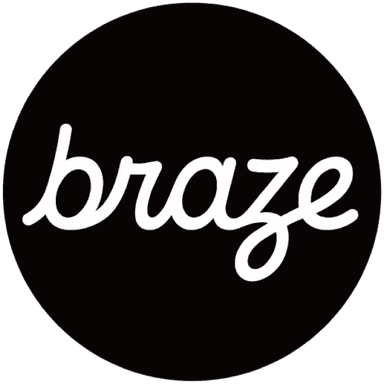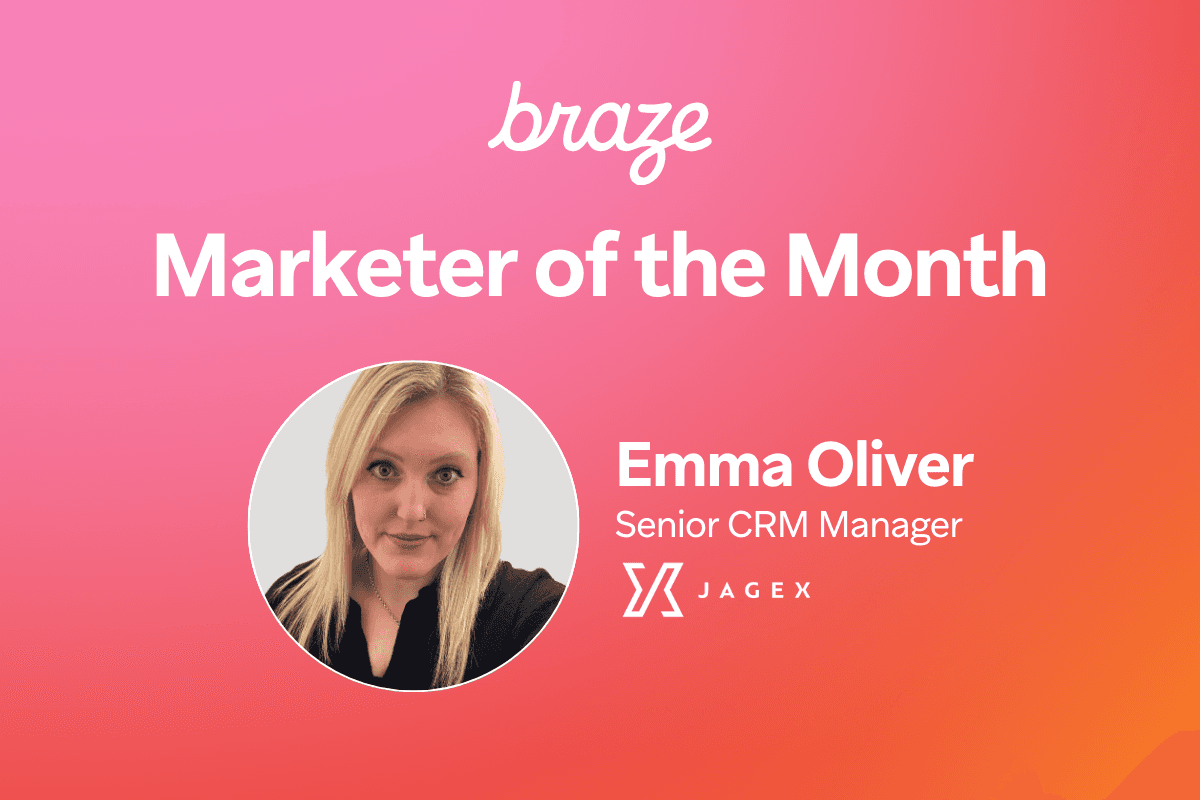Customer engagement at enterprise scale: What works, what doesn’t, and how to fix it
Published on September 09, 2025/Last edited on September 09, 2025/10 min read


Team Braze
For our 2025 Global Customer Engagement Review, we surveyed 2,300+ marketing leaders across the world and organizations of all sizes. However, today, we’re looking at how enterprise organizations with 2,500+ employees are performing compared to the average for all organizations. Keep reading for actionable tips on how enterprises can catch up or get ahead.
While enterprise organizations are often seen as the gold standard in customer engagement, backed by substantial resources and advanced technology, our recent research reveals opportunities for growth and improvement.
These organizations may often leverage high-tech tools and sophisticated data practices, but there are still gaps to address. Our findings indicate that just having scale does not always equate to optimal performance and that enterprises may encounter challenges such as siloed systems and resource constraints that can limit their marketing initiatives.
To provide targeted insights, we’ve organized our findings into five key themes that highlight areas for improvement and growth for enterprise brands.
Structure and synchronization
Truly cohesive and impactful customer engagement doesn’t live in a vacuum. It exists at the intersection of marketing, product, data, and tech. That’s why cross-functional collaboration is critical, but enterprises are struggling to make that collaboration work. 69% of surveyed enterprise brands have siloed customer engagement in the marketing team vs 63% on average.
Our data shows that only one surveyed enterprise organization reached the top performance category for cross-channel customer engagement ownership (Ace), compared to 3% overall. And 85% of enterprises sit in the lowest performance category (Activate), compared to an 82% overall average.
More frequent cross-departmental synchronization could help ensure relevant teams feed into strategy and execution. Our top performers meet several times a week at least. However, the most common sync frequency in enterprises is monthly, and many only sync quarterly or annually.
This lack of cross-team collaboration puts many enterprise marketers at a significant disadvantage, with reduced access to the product, data, and technical expertise they need to execute effectively.
Perhaps counterintuitively, given the siloed structure of customer engagement ownership in enterprises, they’re more likely than average to have a shared, cross-organizational definition of success for customer engagement. This shows that while strategic alignment exists in theory, the structure to support it in practice is lacking, probably due to sheer organizational complexity.
Take action on silos and synchronization
- Align structure with strategy – Establish clear cross-departmental ownership of customer engagement. If that’s not possible, focus on enhancing communication and collaboration across teams.
- Make regular syncs non-negotiable – Aim for weekly coordination between marketing, product, data, and tech teams to align on campaign planning, execution, and insights.
- Balance depth with efficiency – Combine monthly deep-dive sessions with lighter, weekly check-ins to maintain momentum without overwhelming calendars.
Experimentation and evaluation
Effective cross-channel engagement depends on continuous experimentation, testing what, when, where, and how you communicate. There are so many elements at play that can increase engagement, from channels and timing, to content and cadence.
Enterprise organizations understand this well. 62% are in our highest performance category, with continuous, concurrent testing built into their strategy and outperforming the average of 57%.
But it’s not all A/B testing and insightful experimentation. 40% of enterprise marketers say they’d like to experiment but can’t due to resource constraints, compared to an average of 32%. This could be due to restricted headcount, inefficient processes, or inadequate tooling. Whatever the cause, it’s preventing two-fifths of surveyed enterprise marketers from experimenting, refining, and improving the impact of their campaigns.
Speaking of impact, enterprise KPIs are predictably skewed a little more towards financial metrics than the average. Customer lifetime value and operational expenditure are high on the agenda, showing enterprises are concerned about balancing the books and making a profit (who isn’t?). But revenue per campaign ranks lower as a priority KPI.

That’s unlikely to reflect a lack of interest in revenue, but rather the complexity of accurate revenue attribution in such large organizations. With limited resources and less ready access to data expertise, enterprise marketers may focus on metrics that are easier to evidence.
Given that resource constraints are already curbing enterprise marketers’ ambitions, it’s disappointing to see 15% of survey respondents are facing budget cuts in the next twelve months (higher than the 11% average). Could clearer links between customer engagement and revenue generation be the answer?
Take action on experimentation and evaluation
- Streamline workflows to reduce resource load – Consolidate tools and automate manual processes to free up team capacity for experimentation (and other value-adding tasks)
- Start small – Even small improvements are better than stagnating. Start small with quick-win A/B tests with minimal setup, like subject line variation, before building higher sophistication
- Strengthen your reporting – Partner with finance or data teams to improve attribution and demonstrate the financial value of your work, it could mean better buy-in and budget
Data, segmentation, and execution
Enterprise organizations often have advanced tech stacks, but IT investment isn’t equally distributed. While big businesses outperform on performance measurement tools (more on this later) but they’re behind when it comes to cross-channel engagement tools.
Most rely on multiple, channel-specific platforms to plan and execute their cross-channel campaigns. This is disjointed and inefficient, risking the customer experience and wasting valuable resources. Only 28% of enterprises use a single platform that automatically optimizes at the customer level which channel they hear from the company on.
This tech fragmentation is also reflected in how enterprises sort and use customer data. They’re:
- Less likely to combine customer data into a unified profile
- More likely to use basic segmentation, such as channel preference, instead of real-time behavioral data
That means communication may lack cohesion and miss the moment when a customer is most engaged, reducing conversion opportunities. Siloed point solutions and limited collaboration between marketing and data teams are likely culprits.
That said, enterprises aren’t ignoring the power of enriched data. They are more likely to:
- Augment customer data with third-party and zero-party data sources
- Apply data modeling techniques to enhance segmentation
This suggests a willingness to go deep on data, but a struggle to make it usable in real-time.
Take action on data, segmentation, and execution
- Unify your data sources – Integrate disparate data sources to form a comprehensive, unified customer profile that enables you to deliver cohesive and timely communications.
- Move beyond basic segmentation – Utilize real-time behavioral data and advanced data modeling techniques to create more precise and dynamic customer segments
- Foster marketing and data team synergy – Partner with data teams to break down silos, better utilize enriched data, and develop strategies that are both data-driven and customer-centric.
Personalization and emotional resonance
On the personalization front, enterprises score slightly higher on most of the techniques in our survey, from send-time optimization to leveraging past customer behavior like viewed or purchased items. They’re also above average for scalable, tech-driven approaches, particularly:
- Send-time optimization
- Dynamic customer context pulled via APIs
- Targeted, personalized web and app content
These approaches are mostly automated and don’t require significant manual input, which suggests that some enterprises have more tech than teams at their disposal when it comes to resources. But it’s impossible to tell whether that’s because of strategic intent or financial constraints.
This tech preference is also reflected in how enterprises address emotional resonance, where we find another interesting divide. While 85% of organizations are at least somewhat concerned about emotional impact, only 78% of surveyed enterprise marketers are.
Whether that’s a sign of confidence or a lower prioritization is unclear, but when enterprises do try to enhance emotional impact, they’re more inclined towards tech-based tactics like:
- Personalizing messages based on customer data and channel preferences
- Capitalizing on time-sensitivity or timing using technology
- Adjusting messages received in a flow based on how each individual engages

The top tech-based tactics are as follows:
Time sensitivity 41%
Channel personalization 40%
Auto flow adjustments 39%
Whereas the top content-based tactics are:
Community focus 38%
Humour and pop culture 38%
Social proof 37%
While effective, these techniques can equally be applied to a single channel as a cross-channel campaign, so the data reveals little about overall cohesion.
Take action on personalization and emotional resonance
- Balance automation with creativity – Pair tech-driven personalization with human-centered content for scalable content that still resonates emotionally with your audience
- Design for moments, not metrics – Go beyond timing and channel optimization by building campaigns around customer journeys, high-influence touchpoints, and real-time engagement
Performance measurement and campaign adjustments
Enterprises are strong when it comes to measuring the performance of their customer engagement efforts. They export performance data into business intelligence platforms, use advanced tools to determine efficient or high-value successes, and sync performance feedback with insights from other platforms at a higher rate than average.
However, they’re less effective at using that data to inform future campaigns or adjust ones that are already live. Enterprises are:
- Slightly behind on using performance feedback to automatically adjust in-progress campaigns
- Less likely to review performance results before launching new campaigns
This may be due to the complexity of the tech stack, siloed teams, marketers’ access to data expertise, or those resource constraints raising their head again. Whatever the cause, it limits enterprises' ability to turn insight into action.
A unified campaign platform that brings planning, data, and execution together could make it far easier to respond quickly to what’s working and what’s not.
Take action on performance measurement and campaign adjustments
- Empower marketers to use live data – A customer engagement platform streams live data from every channel – and can automate decision-making, letting marketers act on real-time insights without needing external data expertise
- Make performance reviews more than a nice-to-have – Ensure new campaign planning kicks off by reviewing what worked – and what didn’t – previously
- Create cross-functional ownership – As before, bring marketing, product, data, and tech teams together to combine expertise for more effective strategy and execution.
Final thoughts: Many challenges, one solution
Enterprise organizations face a unique and sometimes surprising set of challenges in customer engagement. Despite seeming tech and resource rich at face value, they’re often held back by structural silos, uneven tech priorities, and resource constraints. Scale simply does not equal seamless when it comes to the cross-channel customer experience.
Fortunately, these barriers can be broken down with a relatively low investment in a dedicated customer engagement platform, to empower cross-functional teams to work effectively and efficiently together.
- Dismantle silos — Centralize data sources and campaign execution on one platform to support true cross-functional ownership and collaboration
- Simplify your tech stack – Eradicate legacy point solutions for each channel, to increase efficiency and cohesion in cross-channel campaigns
- Reduce resource constraints — Streamline workflows and increase your capacity without adding extra headcount
- Perfect your personalization — Use easy, logic-driven customer journey builders paired with live, real-time engagement data to deliver more relevant experiences
- Enable experimentation — Leverage built-in A/B and multivariate testing tools to mobilise experiments fast, so you can test, learn, and optimize continuously
- Automate in-flight optimizations — Automatically adjust campaigns in real time based on performance, shifting users to their most effective variant without manual intervention
This unified approach streamlines campaigns and creates more engaging customer journeys, driving higher conversion rates and, ultimately, revenue.
Learn more about how Braze supports enterprise businesses and their unique challenges by reaching out to our team.
Related Tags
Be Absolutely Engaging.™
Sign up for regular updates from Braze.
Related Content
View the Blog
The new inbox reality: How iOS changes are reshaping email marketing

Aparna Prasad

Experience optimization: Turning data insights into better journeys

Team Braze

December 2025 Bonfire Marketer of the Month: Jagex’s Emma Oliver
